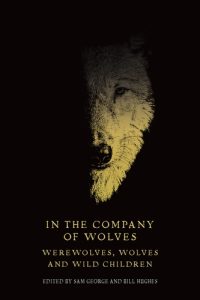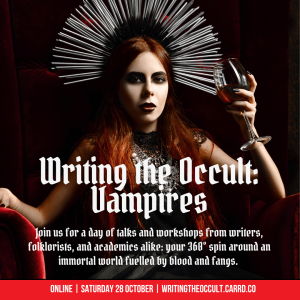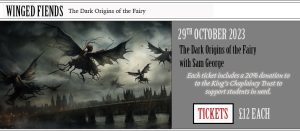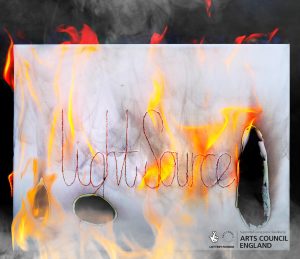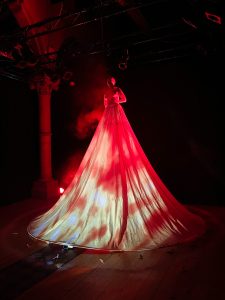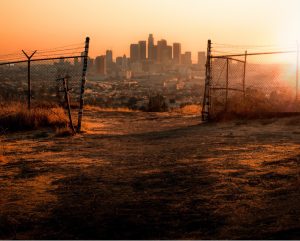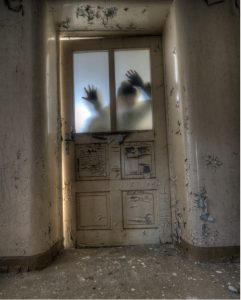Posted March 24, 2024 by Léon Isabelle
My First Encounter with the Gothic… And the Fascination It Triggered
I remember quite correctly the first time I saw a goth person. It was on TV. In the west part of Québec, the city where I grew up, non-conventional looking people were — and still are — a rare sight. Plus, my family was never really fond of gothic literature, let alone goth rock or horror movies. The forbidden attracts, I guess.
In my early teenage years, I avidly watched American crime solving TV series NCIS and one of the characters, forensic Abby Sciuto, struck my imagination with her spider web tattoos, black pigtails, chokers, knee-high platform boots and her taste for industrial artists Android Lust and Nitzer Ebb she would blast in her lab. The 13-year-old I was had never encountered someone like this in real life or even on screen. Abby was also smart, eccentric, upbeat, compassionate, optimistic and dedicated to her work. I was left with one consequential and significant first impression: goth was a positive thing. It went down as the first time I encountered something I knew was ‘gothic’.

What truly made me dive into the rabbit hole of gothic was a mainstream TV show about the investigation service of the U. S. Navy. I know. How ungoth. But the fact remained Abby had opened my mind. Curious in nature, I progressively began searching on what gothic meant. I wanted to know more. From high school to university, I was given opportunities to satisfy that thirst. It started with the poems of Baudelaire and Prosper Mérimée’s 1837 fantastic novel La Vénus d’Ille in literature class. One year in English class, we read a collection of short gothic novels. It is the only English school books I kept after high school.
As I always do when I discover works of art that resonate with me, I dig deeper to know more about the genius(es) behind them. My encounter with Edgar Allan Poe (both the man and his work) was a huge step in my addiction. For those who are wandering, yes, it is possible to be hooked to writers who master the English language via French translations, even more so when translators are poets like Charles Baudelaire and Stéphane Mallarmé. This was particularly true about The Raven, for beyond its rhymes and hypnotic rhythm addressed universal themes, such as the sinister creeping of despair caused by mourning, ultimately morphing into madness.
The gothic had infiltrated my fiction writing, my photographs, and even my academic research. My decision to complete a master’s degree and my choice of master thesis subject was practically based on the fact I wanted to talk about goths’ representation in the media. So, I conciliated that with my interest for the sociological aspect of violence and spent a couple of years researching about the instrumentalization of the Columbine High School shooting. But by that time, I had figured out what my real first encounter with the gothic really was.
A film I watched repeatedly back in my preschool years was Disney’s 1940 Fantasia, its beautiful drawings and its larger-than-life orchestra music. In Fantasia, one segment used to scare me more than others: the one with the bat-winged demon on top of a mountain, calling for the ghostly skeletons to come out of their graves. The Night on the Bald Mountain by Modeste Mussorgsky which accompanied the animation was frightening in itself. Cold shades of blue and purple contrasting with the bright orange of Hell’s fire, emphasized by the dark minor scale and the musical arrangement made the segment gothic for eyes and ears. It later became my favorite part.
A classic case of ‘It was there all along’.
Not long after I had discovered Fantasia, I received the 1949 Disney’s adaptation of The Legend of Sleepy Hollow on VHS that became our family’s Halloween classic. Was I scared? Due to my very young age, maybe a little. But the fascination for the last scene’s gloomy settings — a Halloween party, an old cemetery, a chase through a creepy forest, and a hefty dose of dark secondary colors — overshadowed the fear. To a 5–6-year-old’s eyes, these images were uncommon, uncanny, unreal, so different from everything else. Those images had something magical. Fear went away quickly.
By Léon Isabelle

 As a child, I was fascinated by ghost stories. While no one else in my family liked my weird obsession with ghosts and horror stories, this always gave me the opportunity to explore the world of the undead through my imagination. It was just a different to be in; while others were most into adventure stories and something with moral lessons, I always crave a different angle– the angle of terror and fear. The world of witches, vampires, and monsters was my stomping ground well they still are; I have not left that world.
As a child, I was fascinated by ghost stories. While no one else in my family liked my weird obsession with ghosts and horror stories, this always gave me the opportunity to explore the world of the undead through my imagination. It was just a different to be in; while others were most into adventure stories and something with moral lessons, I always crave a different angle– the angle of terror and fear. The world of witches, vampires, and monsters was my stomping ground well they still are; I have not left that world.


